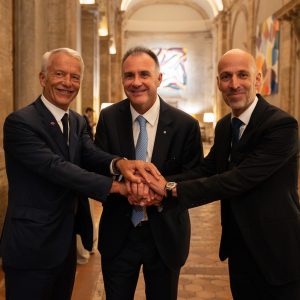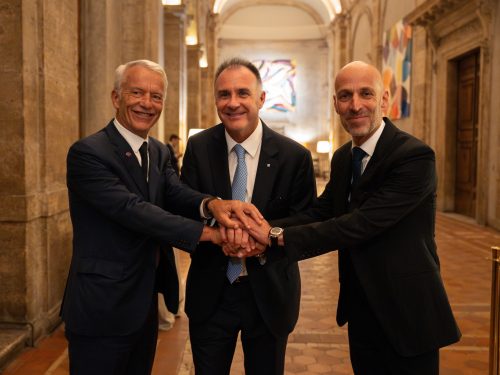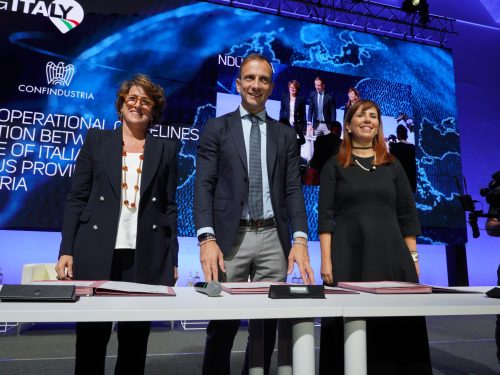News
Share on
The Director General of Confindustria, Maurizio Tarquinispoke at a parliamentary hearing on the Draft Budget Law 2026, explaining the position of the Association on the economic context and planned measures. In his speech (the full version of which is downloadable here), Tarquini pointed out that the global scenario is 'even more uncertain than last year' due to tariffs and geopolitical tensions that 'put pressure on value chains, curb exports and reduce household confidence'.
"256,000 companies with more than 10 employees, together with the 10 million employed, keep more than 80% of our public finance and social protection system afloat: this is what is at stake," said Tarquini, recalling the risk of losing our production base.
Public accounts: a positive figure, but not enough
Political and account stability has reduced spreads and yields of BTPabout 30 bn/year less interest, 5 bn already in the first year. But growth is back to zero. The PNRR remains decisiveIn addition to boosting investment, it plays a counter-cyclical role that avoids stagnation, at a time when even Germany, France and Spain are leveraging public investment to grow.
An extraordinary industrial plan is needed to boost competitiveness
The Budget Law 2026 mobilises resources of EUR 21.3 billion in 2026, 18.8 in 2027 and 16.4 in 2028, but the overall impact on GDP is zero. While recognising the government's willingness to engage in dialogue and appreciating measures such as the hyper-amortisation and the Single SEZTarquini emphasised that the manoeuvre 'does not have the right dimension to boost competitiveness'.
Hence the request to implement an extraordinary industrial plan that goes beyond the constraints of individual budget laws and is based along three structural lines: investment, competitiveness and attractiveness. A plan capable of strengthening supply chains, supporting innovation and ensuring a favourable environment for growth, also in the light of the industrial policies introduced by other European countries.
Priorities involve the NRP and the cost of energy
Among the priorities emphasised by the CEO of Viale dell'Astronomia, that of reshaping the PNRR to strengthen support for productive investments (at least 8 billion/year for three years) and that of containing the cost of energy: the average price in Italy in the first 10 months of 2025 - recalled Tarquini - stands at €116/MWh compared to €87 in Germany, €65 in Spain, €61 in France and significantly lower figures for the United States and China. For these reasons, Confindustria's requests are clear: PPAs/long-term contracts for renewables, decoupling of electricity prices from gas prices, elimination of the TTF/PSV spread, and reduction of system charges. 'The problem can no longer be postponed,' Tarquini pointed out.
The measures of the Manoeuvre: steps forward, but perspective and resources are needed
Confindustria welcomes the introduction of of the hyper-amortisationThis measure is a positive signal for investments in innovation, digitisation and self-production of energy. However, its application limited to 2026 alone is deemed insufficient to guarantee the necessary stability for industrial planning. The Association calls for a horizon of at least three years, effective from 1 January 2026, and the possibility of also including investments already started in 2025.
Also positive is the extension of the tax credit for the Single SEZ to 2028which largely incorporates the proposals of Confindustria. The multi-annual extension and the certain budget are important steps, but technical aspects such as the valorisation of the SAL and integration with European cohesion funds.
More critical are the assessments of development contractswhich are considered an essential lever but are held back by complex procedures and insufficient resources: the 550 million foreseen for the three-year period 2027-2029 is not enough to support the demand for new industrial projects. On Guarantee Fund for the SMEFinally, Confindustria calls for the current rules to be made structural, strengthening their role as a stable instrument for access to credit.
Criticism on tax, labour and infrastructure
Strong concerns were expressed about some tax measures that were considered penalising. The increase to 24% of the taxation of intra-group dividends for holdings of less than 10% risks reducing the ability of Italian companies to attract capital, while the prohibition - from 1 July 2026 - of Offsetting tax credits via F24 with INPS and INAIL contributions can generate liquidity tensions, especially for companies that have made investments.
For interventions in support of workers' purchasing powersuch as the tax incentive for contract renewals and the reduction of taxation on productivity bonuses, which were agreed in principle, their temporary nature and the risk of misalignments were highlighted. Also reiterated was the need for targeted incentives for hiring in southern Italy and the extension of the expansion contract to accompany industrial transitions.
Finally, critical issues remain in strategic sectors such as health, research and intermodal logisticstogether with the absence of measures on thehousing emergencywhich restricts the mobility of workers and hinders the matching of labour supply and demand.
Growth, enterprises and the future of welfare: a strong alarm
Confindustria calls for shared, long-term political choices.
"We must not resign ourselves to the zero-point syndrome," said Tarquini.
Without growth - and without businesses that generate it - it will not be possible to maintain current welfare levels. Fiscal stability is 'a good choice', but it must be accompanied by a structural commitment to competitiveness. The priorities remain three: PNRR reshaping, energy cost reduction and zero-cost reforms for an Italy that is simpler, more attractive and capable of enhancing the value of those who invest.

















